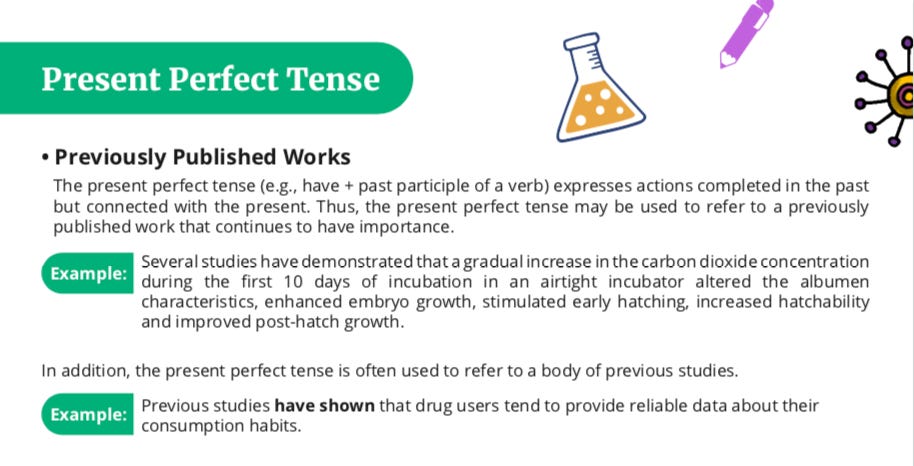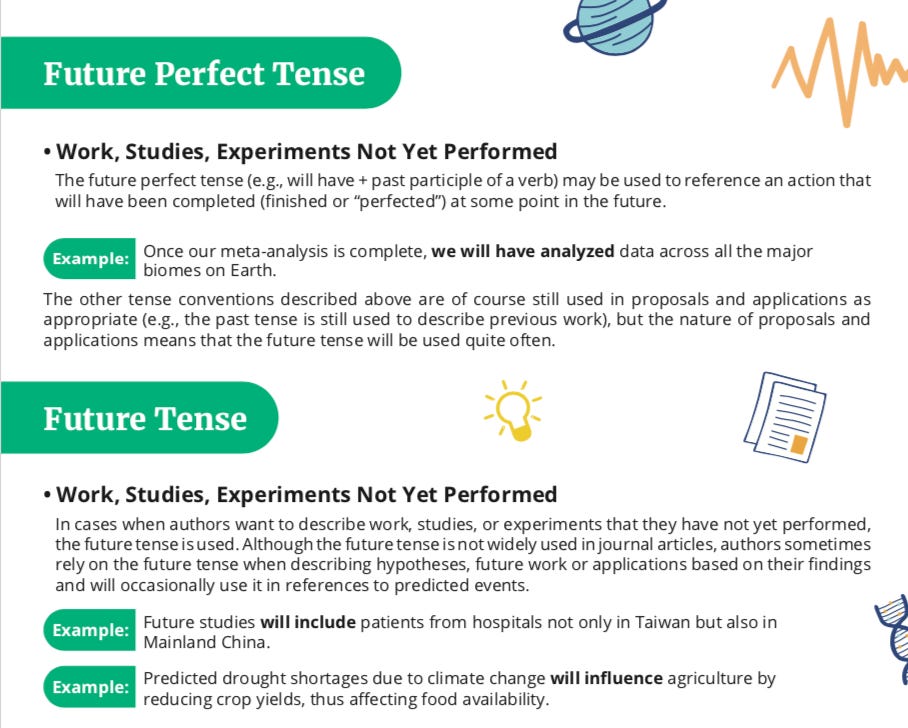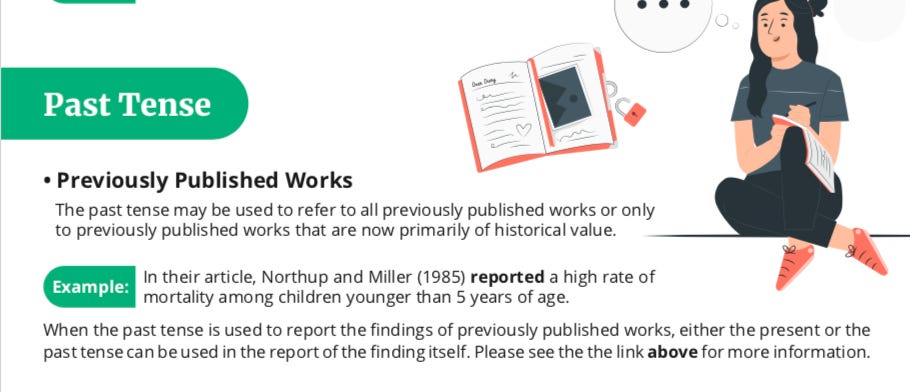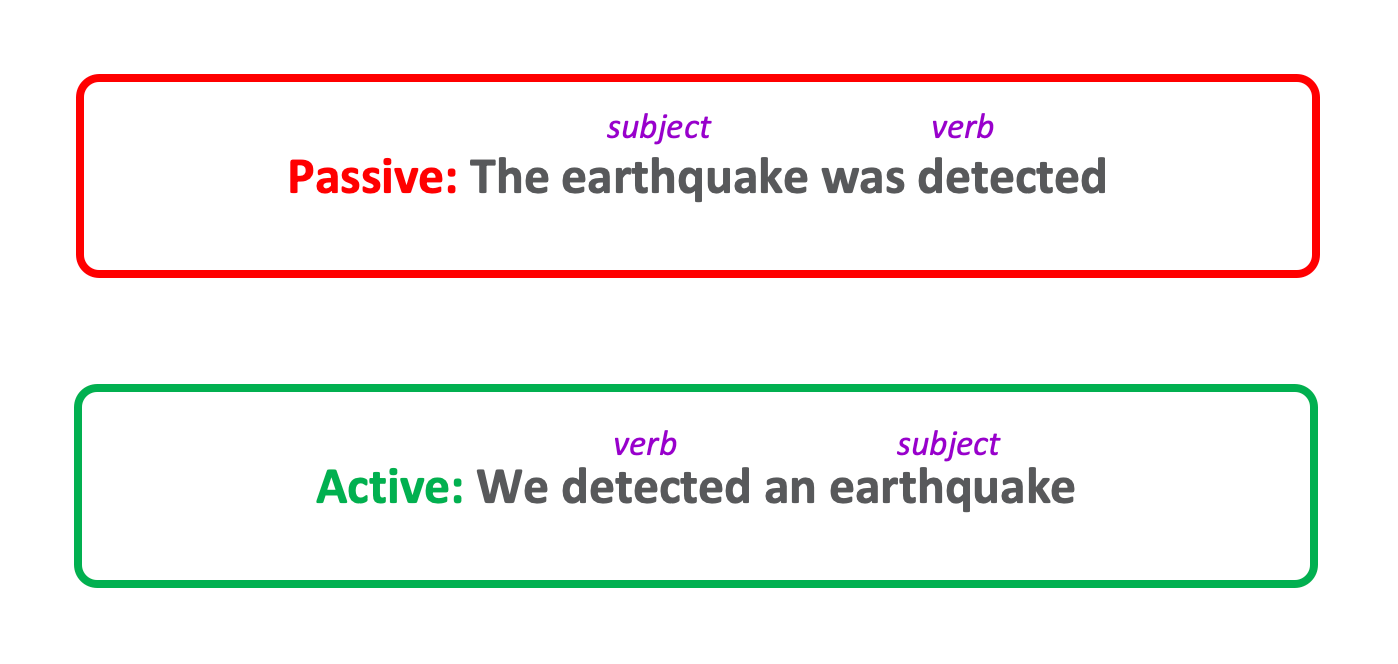Don't get TENSE: Should I be 'active' or 'passive' in my writing?
Is it better to be ‘active’ or ‘passive’ in your English academic writing? PDF downloads and videos ... (PLUS a FREE Webinar this week!) AND WHEN should you use “It’s” versus “Its”?
Academic writing is difficult in any language, let alone your second or third!
The aim of this blog is to help you to be as effective as possible when writing and communicating in English, including in scientific articles.
We’ve put together some helpful content to assist!
Quick Guide to the use of Tenses in Academic Writing (LINK BELOW FOR FULL FREE PDF — It’s very helpful ….)
(These are just Snippets: LINK BELOW FOR FULL FREE PDF — It’s very helpful ….)
Why not: Join us for some FREE Webinar TRAINING? (Coming up this week!)?
WEBINAR: PUBLICATION PLANNING Wednesday, June 25, 2025 1:00 PM (GMT)
In this FREE skills-building event, we will discuss the most efficient ways to plan your next research project.
This involves finding a gap in the literature to fill in with your novel findings and then selecting the perfect journal for your paper.
We will also discuss some of the most common research writing mistakes that can lead to rejection -- and how to prevent them in the early stages!
Join us as we outline key publication planning steps to enhance your chances of acceptance in high impact factor, SCI-listed journals.
Want to save days, weeks, or months of wasted time on publication? Join us!
AND NOW: Back to the Blog ….
One of the most common questions I am asked is: ‘which tense is it best for me to use when writing an academic paper?’ Should I use the third person passive voice (‘an experiment was conducted’, ‘data were collected’) or first person active (‘we carried out an experiment’, ‘our team collected data’)? This is a very difficult and common question because most of us were taught at school or in earlier writing courses to always use the third person in our technical writing. This might not be the best thing to do though, however.
Why?
Because reading a paper written in the third person is boring. It’s much more engaging and interesting to read an article when it’s written in the active first person.
One of the great things about writing is that it’s a creative process and there is no right, or correct way. One of the best pieces of advice I was ever given was ‘try to write in the way that you think’. Put down your thoughts on paper as they come into your head. You can polish and edit later.
Don’t believe me about the use of the first person in writing? Have a look online: lots and lots of articles have been written on this topic and, I think you’ll agree, reading something that’s written using the active, first person tense is a much more engaging experience. Your less likely to get bored, lose interest, and move onto something else. Our goal as researcher writers is to capture people’s attention with our paper writing and then, hopefully, keep them interested all the way through the paper to the end. Ask yourself this: when was the last time you read an academic paper all the way through to the end? In my case, ages ago: I usually just skim read after having looked at the title and the abstract. As an editor, I admit to often making decisions about papers (whether to send them out for peer review, or not, just based on the title, abstract, and covering letter).
These are issues to bear in mind
Have a look at a recent issue of Nature or Science (journals that, lets face it, we’d all like to get our work published in at some point): you’ll find that about half of the papers in the current issue of Nature are written in the first person active tense in English while the rest are in the more boring third person.
Which is better?
You be the judge. Above all: find a writing style that works for you and then try to stick to it in your written work. Don’t allow yourself to be pushed into writing in a style you feel uncomfortable with but, please, here are two good tips for improving your written academic English: (1) if you decide to write in active voice in your next article, stick to this throughout the text, and; (2) try to think as you write in English. Try not to think in your native language and then translate in your head as you put down the words, or once you’ve written down some text. Thinking as writing in the language you are working in is absolutely key to being effective.
Why?
Because good, clear writing in any language is specific to that particular case. The short, clear, punctuation-light sentences we want to see in English might not be characteristic to other languages.
Returning to the first of these top tips, one of the most common mistakes that ESL colleagues make when writing their papers in English is mixing tenses: starting off in the active, first person (‘We aim to do this …’, ‘We performed a series of experiments’) before then using the third person later in their paper, most often in the materials and methods (‘Data were collected’, ‘A series of experiments were performed’). Jumping about like this is jarring for readers and will make your article much less accessible. Editors also hate this kind of thing and will work to fix changes in tense throughout your written work if you chose to use a language polishing service, for example.
Some of the other common issues we encounter when working with ESL authors include the use of inappropriate words in English and mixing up American and British spellings.
The use of inappropriate words just refers to usage that might sound strange to a native English speaker when applied in technical scientific writing.
I recently edited a paper that was written by a leading Chinese medical doctor which included the phrase ‘the government should not let the grass grow under it’s feet when it comes to dealing with the gathering national crisis in antibiotic resistance. Patients who are resistant to antibiotics are springing up like mushrooms all over the country’.
I’ve highlighted the phrases here that seem odd to a native speaker when included within academic writing. These usually come from translation or the use of online searches to find phrases that match with usage in a writer’s native language: another good reason why, as we mentioned above, it’s a good idea to try to think in English when writing in English. Words like ‘amazing’, ‘marvelous’, and ‘fantastic’, in English so-called superlatives, are often also encountered in the writings of ESL authors: ‘the fantastic potential of land use changes in China’ and ‘a marvelous new application for digital elevation models’ are two recent examples from my experience.
What about spelling conventions? Well, these can be incredibly confusing: the myriad differences between American and British English, as outlined above. Did you know, for example, that there are two spellings for the color/colour gray/grey (America/British)? Although you can always set the spelling correction function in your word processing software to either convention it’s well-worth proof-reading before you submit and check the guidelines of the journal you are planning on submitting too: many journals don’t care which spelling convention you use so long as you keep it consistent (don’t mix the two kinds of spelling in one article, one very common issue that editors hate: ‘analyze the colour’, for the example), while others specify American or British conventions in their ‘guidelines for authors’. An editor will quickly be able to spot if you’ve quickly re-worked a paper that was recently rejected from another outlet and then resubmitted it to them; put some time into this to maximize your chances of success!
Another good tip is to check out a handful of papers in your own field that have appeared recently in high impact factor journals that you think are well-written and easy to read. Don’t copy, but you can base your style on the work of others: how are the papers that you find easy to read and follow written? Do they use the first person active tense? (I bet they do). This also works well for developing your figures and tables: how do other successful authors put these together in their papers? What sorts of styles, software, colors, and formatting do they use?
Above all, you want your academic papers to be fun to write and easy to read! There’s no need to be tense.
Here comes the DETAIL
A sentence is in active voice when the subject is the one performing the verb’s action.
Example
The girl has written a letter.
Most English sentences with an action verb are written in the active voice. However, it is possible to change the word order of some active sentences to render them passive sentences. A sentence is in passive voice when the subject is being acted on by the verb.
Example
The letter has been written by the girl.
What is Voice?
English verbs have five properties: voice, mood, tense, person, and number. There are two grammatical voices: active and passive. Active voice means that the subject performs the verb’s action, while passive voice means that the verb is acting upon the subject. The same content can often be written in both active voice and passive voice.
Example
We fabricated the composites in a clean room (active)
The composites were fabricated in a clean room (passive)
The active voice emphasizes the subject, or the thing performing the action. The passive voice, on the other hand, emphasizes the action or the recipient of the action. Schools typically teach students to avoid the passive voice whenever possible. This is because sentences in active voice tend to be stronger and more concise. However, the passive voice can be more appropriate depending on the context. The passive voice is also useful when you want to avoid using the first-person pronoun in academic writing.
Previous hits from the blog:
Tips and Tricks for Navigating the Manuscript Submission Process
Why Publish a Paper and Things to Know Before you Start
This section is sponsored by Virtus Publishing: You can get 20% off self-publishing your book with Virtus ….
In a series of posts within posts, our friends at Virtus Publishing will provide tips and advice covering many aspects of publishing. This next series will be an ongoing selection of language tips, covering areas that many copy editors (and authors) find difficult. These will be short and to the point.
Virtus Publishing Language Tip #14: “It’s” versus “Its”
An issue I see regularly in plenty of published work (especially online) is the incorrect use of “it’s” versus “its.”
This really shouldn’t happen because there’s a simple distinction to understand and the rules are very simple. Nevertheless, many writers make the mistake of confusing these two words.
The only time an apostrophe should be used after “it” is when forming a contraction: when “it is” or “it has” is intended.
“It’s a beautiful sunset” (meaning “it is a beautiful sunset”)
Let’s look at a rule on the Grammarbook.com website (a great resource). As always, the end of the quoted material is denoted by the box (∎):
Rule 1: When you mean “it is” or “it has,” use an apostrophe.
Examples:
It’s a nice day.
It’s your right to refuse the invitation.
It’s been great getting to know you.
Rule 2: When you are using “it’s” as a possessive, don’t use the apostrophe.
Examples:
The cat hurt its paw.
The furniture store celebrated its tenth anniversary.
∎
For some writers it may be confusing because the possessive form for proper nouns does require an apostrophe, for example, “John’s car” or “Sally’s recipe.”
Unfortunately, with so much material written on a phone (and in a hurry), errors like this can creep in. It’s always a good practice to proofread what you’ve written to catch such errors.
Like this post? Follow Virtus Publishing on LinkedIn!
Have you ever wanted to publish a book? Virtus Publishing’s self-publishing services can make it happen! A global service provider, Virtus has the industry experience and dedicated staff to turn your book idea into reality.
Send an email to david@virtuspublishing.com to set up a free consultation. Mention the keyword “Seagull” and receive 20% off your first order.















